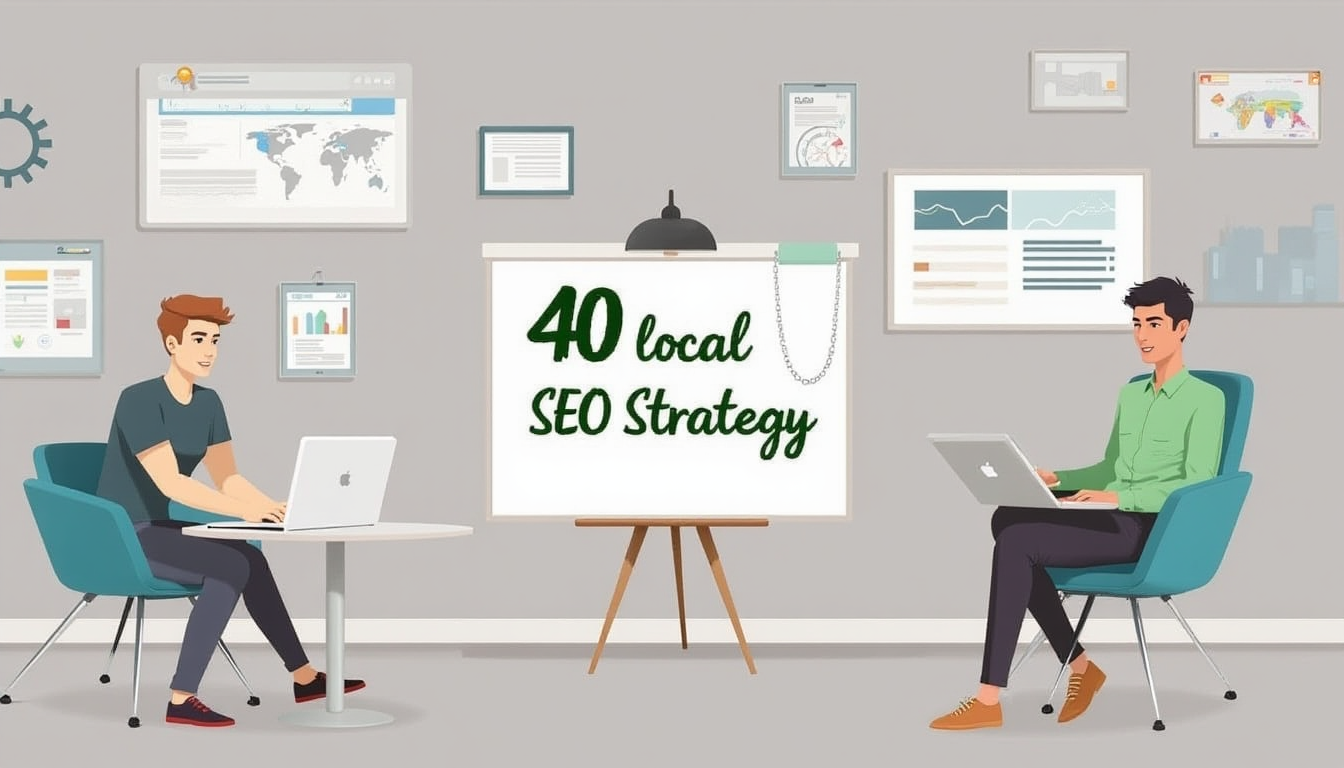Local SEO is crucial for businesses aiming to attract local customers. It helps improve visibility in local search results. With the right strategies, you can stand out in your community. This guide covers 40 essential local SEO strategies. Each strategy is designed to boost your local search presence. From optimizing your Google Business Profile to engaging with local communities, we've got you covered. You'll learn how to use local keywords effectively. Discover the importance of customer reviews and mobile optimization. We'll also explore local content marketing and backlink building. Get ready to enhance your local search optimization efforts.
What Is Local SEO and Why Does It Matter?
Local SEO is all about optimizing your online presence for better local visibility. It ensures your business shows up in local search results. Why is this important? Most consumers look for local information online before visiting a store. Without local SEO, your business might miss out. Local searches often lead to more conversions. People searching locally have immediate needs, ready to buy or visit. Key factors in local SEO include Google Business Profile optimization and customer reviews. Consistent NAP (Name, Address, Phone)details also play a pivotal role. Implementing local SEO strategies helps engage with local customers and build community trust.
How Local SEO Differs from Traditional SEO
Local SEO targets audiences within a specific geographic area. In contrast, traditional SEO caters to a broader or national audience. Traditional SEO focuses heavily on keyword relevance and backlink strength. Local SEO, meanwhile, emphasizes location and proximity. For local SEO, Google Business Profiles and reviews hold more weight. Traditional SEO places more importance on content quality and domain authority. Key components of local SEO include:
- Google Business Profile management
- Local citations and directories
- Proximity and location
Understanding these differences helps businesses tailor strategies effectively to reach local markets.
The Local SEO Ranking Factors You Need to Know
Local SEO ranking factors are crucial for boosting online visibility. These elements help businesses connect with nearby customers effectively. Key factors include relevance, distance, and prominence. Relevance ensures your business aligns with local search queries. Distance measures your business's proximity to the user. Prominence determines how well-known your business is within your area. This involves reviews, directory listings, and online mentions. Important local SEO ranking factors include:
- Google Business Profile
- Online reviews and ratings
- Local keyword relevance
Prioritizing these factors can significantly enhance local search performance and drive more local traffic.
40 Essential Local SEO Strategies for 2025
Boosting your business visibility in local searches is vital. Here are 40 local SEO strategies for2025 you need to know. Implement these tactics to enhance your presence and attract local customers. From optimizing your Google Business Profile to engaging in community events, these strategies will guide you. Use them to stay ahead in the ever-evolving world of local SEO.
1. Claim and Optimize Your Google Business Profile
Claim your Google Business Profile first. This is your local SEO foundation. Optimization involves:
- Adding correct business hours
- Uploading high-quality images
- Including an engaging business description
2. Ensure NAP Consistency Across All Platforms
Consistency in your Name, Address, Phone Number (NAP) is key. Ensure it's identical across platforms. This prevents confusion and boosts search rankings. Confirm your NAP details onyour website, social media, and directories are identical.
3. Use Local Keywords in Your Content
Incorporate local keywords into your website content. This boosts your visibility in local searches. Focus on:
- Location-based terms
- Industry-specific terms
Implement these keywords in headers and paragraphs for better results.
4. Encourage and Respond to Customer Reviews
Reviews can make or break local SEO. Request positive reviews from satisfied customers. Engage with them by:
- Thanking them for positive feedback
- Addressing any complaints
5. Optimize for Mobile Users
Most local searches are done on mobile devices. Ensure your website is mobile-friendly and loads quickly. Improve loading speed to retain mobile visitors and enhance their experience.
6. Create Location-Specific Landing Pages
Create pages for each location you serve. This targets customers in specific areas. Include local keywords and content relevant to each location. This helps search engines understand your local presence.
7. Implement Local Business Schema Markup
Schema mark-up helps search engines read your content. Implement local business schema to provide crucial business details. This includes location, hours, and services to enhance search visibility.
8. Build Local Backlinks
Local backlinks boost your site’s authority. Collaborate with local websites and blogs for links. Focus on:
- Local directories
- Community websites
These generate quality backlinks.
9. Engage in Local Community Events and Sponsorships
Participate in community events to enhance visibility. Sponsorships bolster your local reputation. Showcase your involvement on your website and social media to attract local attention.
10. Leverage Social Media for Local Engagement
Social media connects you with local audiences. Use platforms like Facebook and Instagram to engage. Share local content, events, and promotions to build a strong local presence.
11. Monitor and Manage Online Reviews
Regularly check review sites for feedback. Respond promptly to manage your reputation. Address negative reviews professionally to maintain customer trust and improve your business image.
12. List Your Business in Local Directories
Ensure your business is listed on local directories. Key directories include:
- Yelp
- Yellow Pages
- Local Chamber of Commerce
This increases your local visibility and search rankings.
13. Improve Website Loading Speed
Fast-loading pages retain visitors. Optimize your website speed for better user experience and SEO. Use tools like Google Page Speed Insights for guidance.
14. Develop a Local Content Marketing Strategy
Create content targeting local interests and events. Blogs and articles relevant to your area engage local audiences. This approach not only informs but also strengthens community ties.
15. Geotag Images on Your Website
Geotag images to improve local search relevance. Add location data to your images. This helps search engines associate your business with specific areas.
16. Track Local SEO Performance with Analytics Tools
Use tools like Google Analytics to track performance. Analyse data to refine strategies. Focus on metrics like traffic, bounce rate, and conversions from local sources.
17. Collaborate with Local Influencers
Partner with local influencers to expand reach. They can promote your services to their followers. Choose influencers relevant to your niche for effective results.
18. Secure Your Website with HTTPS
Use HTTPS for a securebrowsing experience. It protects user data and improves trust. Google favorssecure sites, boosting your search rankings.
19. Use Clear Calls-to-Action for Local Customers
Guide visitors with clearcalls-to-action (CTAs). Encourage them to visit, call, or purchase. Tailor CTAsto your local audience for better engagement.
20. Regularly Update Website Content
Keep your content currentand relevant. Regular updates improve user experience. Fresh content signalssearch engines that your site is active.
21. Optimize Internal Linking Structure
Internal links improve sitenavigation and SEO. Guide visitors with strategic links to related pages. Thisenhances their experience and helps search engines crawl your site.
22. Use Video Content to Engage Local Audiences
Videos grab attention andconvey messages quickly. Share local-focused videos to engage audiences. Topicscan include customer testimonials and community events.
23. Start a Local-Focused Blog
A local-focused blogattracts niche audiences. Share local news, events, and insights. Thispositions you as a community authority and boosts engagement.
24. Participate in Local Online Forums and Groups
Join forums and groupsrelevant to your area. Participate actively to establish connections. Theseplatforms can drive traffic and enhance your local reputation.
25. Run Paid Local Search Ads
Use paid ads to target localcustomers. Platforms like Google Ads allow geographic targeting. This ensuresyour ads reach potential customers in specific areas.
26. Optimize Title Tags and Meta Descriptions forLocal Terms
Include local terms in titletags and meta descriptions. This improves visibility in local searches. Ensurethey accurately reflect your content to attract clicks.
27. Build a Local Link-Building Strategy
Develop a strategy toacquire local backlinks. Partner with nearby businesses and organizations.These links build authority and boost local search performance.
28. Showcase Customer Testimonials and Case Studies
Publish testimonials andcase studies on your website. They build trust and showcase your success.Highlight positive outcomes from previous clients for added credibility.
29. Ensure Website Accessibility for All Users
Make your site accessible tousers with disabilities. Use tools to check and fix accessibility issues. Thisbroadens your audience and improves search rankings.
30. Use Local SEO Tools for Insights and Tracking
Utilize tools to track SEOperformance and gain insights. Identify areas for improvement. Tools like MozLocal offer valuable data and optimization tips.
31. Add a Local FAQ Section to Your Website
Include a FAQ section to address common queries. Focus on local customers' concerns. This improves user experience and boosts local search relevance.
32. Use Structured Data for Enhanced Search Appearance
Structured data enhances search result appearances. Implement it to better inform search engines. This can lead to rich snippets, improving click-through rates.
33. Optimize Images with Alt Text and Local Keywords
Add alt text to images with local keywords. This helps search engines understand image content. It boosts image search visibility in local searches.
34. Distribute Local Press Releases
Send press releases to local media outlets. Announce new services or events. Press releases enhance visibility and attract local media attention.
35. Cross-Promote with Other Local Businesses
Partner with other businesses for cross-promotions. Share audiences and increase reach. This collaboration can strengthen community relationships and brand awareness.
36. Use Email Marketing to Reach Local Customers
Email remains a powerful marketing tool. Send targeted campaigns to local customers. Include promotions, news, and events to keep them engaged.
37. Implement a Local Loyalty Program
Reward loyal customers with a local loyalty program. This encourages repeat business and fosters customer relationships. It strengthens community ties and enhances retention.
38. Post Updates and Offers on Google Posts
Google Posts allow direct engagement with search users. Share updates, offers, and events. This keeps your business information current and visible on search results.
39. Analyze Competitors’ Local SEO Strategies
Study competitors to gain insights. Analyse their strengths and weaknesses. This reveals opportunities for improvement and areas to outshine them.
40. Stay Updated on Local SEO Trends and Algorithm Changes
SEO trends and algorithms change frequently. Stay informed of updates and adjust strategies accordingly. This ensures your tactics remain effective and competitive.
Tools and Resources for Local Search Optimization
Optimizing local search requires the right tools. Here are some valuable resources to enhance your strategy. They offer insights and action able data. Use them to boost your local SEO performance.
Many tools simplify tracking and analysis tasks. Google My Business allows seamless profile management. Moz Local identifies inconsistencies across listings.by Marek Piwnicki
Other tools focus on analytics and performance. Google Analytics provides data on traffic and user behavior. This helps you understand what is working.
Consider the following resources
- Google My Business
- Moz Local
- Google Analytics
- BrightLocal
- SEMrush
These tools uncover opportunities for growth. Use them to refine strategies and maintain competitiveness. Consistently evaluate their effectiveness to adapt as trends evolve.
Common Local SEO Mistakes to Avoid
Local SEO mistakes can hurt your visibility. Avoid these common errors to maintain a strong presence. Errors often arise from oversight. Inconsistent NAP information confuses search engines. Ensure uniformity across all platforms. Another mistake is neglecting user reviews. They influence potential customers' decisions Ignoring mobile optimization is detrimental. Many local searches happen on mobile devices. Ensure a smooth, fast mobile experience. Additionally, don't overlook local keyword usage. Consider avoiding these missteps:
- Inconsistent NAP information
- Neglecting user reviews
- Poor mobile optimization
- Overlooking local keywords
These errors can cost you valuable leads and lower your rankings. Regularly audit your strategy to stayahead. If you really want to learn SEO and get real results , you can learn Seo strageies by enrolling in some seo courses .
Measuring and Tracking Your Local SEO Success
Effective local SEO requires measurement and tracking.Use tools to understand what works. This step is crucial for refining strategies. Google Analytics and Google Search Console provide valuable insights. They help track web traffic and conversion rates. These metrics reveal what's attracting local customers. Set clear goals to gauge progress. Define what success looks like for your business. Compare these metrics regularly to detect trends. Consider using these metrics for tracking:
- Local search rankings
- Conversion rates from local searches
- Customer engagement metrics
Understanding these metrics helps you adjust and improve. With constant tracking, you can optimize your efforts. This ensures continued local SEO success.
Final Local SEO Tips for Long-Term Growth
Staying competitive in local markets means adapting to change. Consistent efforts yield lasting results. Here are some final tips for long-term growth. Focus on building a strong local community presence. Engage with audiences both online and offline. Local SEO thrives on genuine relationships. Regularly update and refine your strategies. Stay informed about new trends and algorithm updates. Being proactive keeps your local SEO dynamic. Key actions to keep in mind:
- Engage actively in local communities
- Regularly review local SEO strategies
- Stay informed about industry changes
By following these practices, your business remains a local favorite. Adaptability and consistency lead to sustained success.


.jpg)




